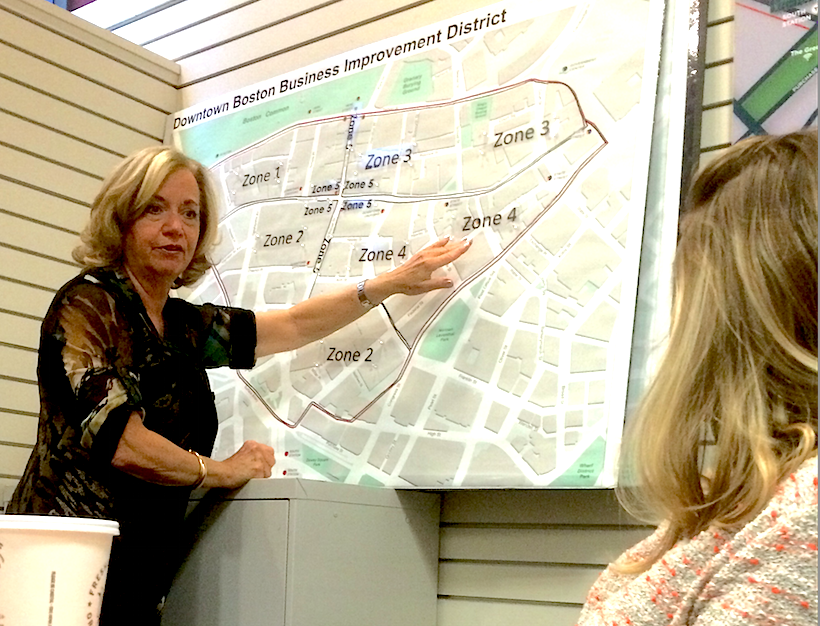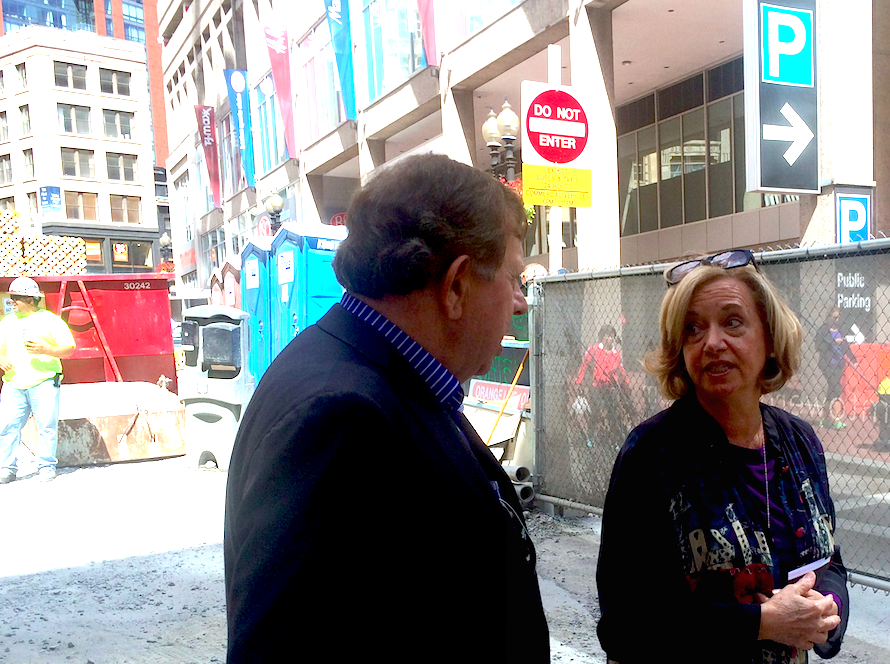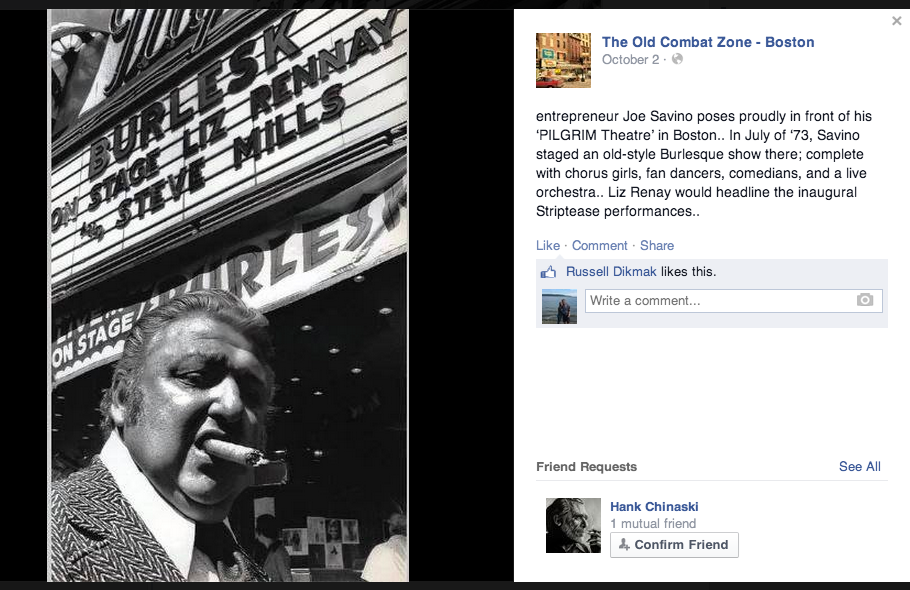
Mayor Marty Walsh is at the helm of Boston — a booming city changing faster and growing taller than most would expect. Suffolk Construction CEO John Fish, the unofficial real estate development king targeting an Olympic bid, is perhaps this city’s supreme influencer. And further down Boston’s hierarchical power structure, stands a snappy, no-nonsense, female Italian, no taller than five-feet-three-inches, confidently pitching Downtown Boston as if it were Times Square, with unsuspected kindness and old-school class.
Developers with a grand vision of what they’d like to see rise from downtown, or what hot startups they’d like to have ink longterm-lease agreements in the 34-square-block area – they go to her: Rosemarie Sansone, the president of the Downtown Boston Business Improvement District. Her true power dawns on me while standing a few arms’ lengths away, eavesdropping on her conversation with the godfather of Boston groundbreakings, Tony Frias – “the guy with all the cement trucks.”
It’s a conversation that begins with Frias, the president of S&F Concrete, celebrating – not acknowledging – Sansone’s arrival in front of an open gate at the Millennium Tower construction site. Rose-mar-IE San-son-E! proclaims Frias excitedly, in a sing-song sort of way, emphasizing the vowels in the BID president’s conspicuously Italian name.
They hug, exchange quick air kisses, and get to talking, leaving then-Schneider Associates account manager Catherine Kellogg and me – two 20-something media professionals – feeling like we crashed a 30-year high school reunion. I quickly realize that, in this mid-September interview and lunchtime walking tour of Downtown Crossing, we have, for the time being, been reduced to mere tag-a-longs.
It’s an awkward sort of feeling – standing here, watching Frias and Sansone catch up. Like waiting to be introduced to adults you don’t know, but should, at a family barbecue: I’m not being slighted, but it’s awkward that I’m hovering nearby. (You’ve experienced this – being with a friend, girlfriend or boyfriend and bumping into another familiar face. Intros are, almost always, given after the fact.)

Frias and Sansone make friendly, albeit executive-level, small talk – a jovial back-and-forth I soon realize is something I should really be paying closer attention to. This let-the-grownups-talk moment is taking place on a sidewalk currently separating the dirt and gravel floor of the billion-dollar construction site from slow-creeping cars, diagonally across from where the high-end Millennium Tower sales office sits, at 50 Franklin Street. Sansone, during a break in conversation, explains to Frias the circumstances of their meeting: She’s giving a reporter, me, a tour of downtown.
Frias’s handshakes are polite, and his interest in meeting these two young people in Sansone’s presence is genuine, but we don’t get our own dose of his boyish, conversational charm; it’s clearly reserved for Sansone. She’s the person who matters.
After four total meetings with Sansone similar to this one – two walkthroughs and two face-to-face interviews inside the BID’s first floor office at 101 Arch St. – I discover why.
Sansone’s presence has been felt around Boston for three and a half decades: through her current work as head of the BID, in politics, and higher education.
“Sometimes producers are also the directors.” – Rosemarie Sansone
In 1978, she became a player in Boston politics when she started her first of two terms as an at-large Boston city councilor. A decade-long gig as director of the Mayor’s Office of Business and Cultural Development under the Raymond Flynn administration followed.
Then, in 1994, Suffolk University, Sansone’s alma mater, tapped her as the school’s director of public affairs, a title she would hold for the next dozen years. While managing the college’s flow of communications and external affairs, Sansone rubbed shoulders with private and public sector powerbrokers, who, before it was the popular thing to do, were looking to invest in what would become a sweeping revitalization project of Downtown Boston, a.k.a. “The Combat Zone” – a once-accepted, though still commonly used, nickname denoting stretches of Washington, Boylston, and Kneeland Street, which were once synonymous with adult entertainment, crime and violence.

Sansone would end up starting her still-active tenure as the biggest advocate of the Downtown Boston neighborhood in 2007, when she transitioned from Suffolk University to the head of the Downtown Crossing Partnership (DCP) – an organization which, by 2010, had ditched “Crossing” and “Partnership” and morphed into the Downtown Boston Business Improvement District.
As BID president, chance midday meetings with men like Frias – Boston businessmen with deep pockets – are normal for Sansone. She makes these impromptu stop-and-chats happen frequently, by consciously popping out of her office at 101 Arch St. for a walk around the block, at least once a day, for 30 minutes to an hour.
During our fourth and final interview for this multi-part profile, Sansone tells me I’m wrong to call her, as others have, “the Mayor of Downtown Boston.” This once-aspiring Broadway star (until her mother told her otherwise), who studied liberal arts at Suffolk as an undergrad before going on to earn a master’s in education from Harvard, now finds herself weighing billion-dollar downtown construction deals. She might as well be a mayor, or some type of politician; men like Frias, this reporter assumes, don’t celebrate the arrival of just an “advocate,” as she prefers to call herself.
Sansone won’t concede the media-concocted title she’s been given. The only title other than BID president she’ll condone is this: Rosemarie Sansone, Producer – Downtown Boston.
Producers – in the film industry, anyway – are the people who accept the Academy Award for Best Picture each year at the Oscars; these are the people responsible for turning a script, or even just an idea for script, and turning it into the finished project they envisioned from the start.
Here’s what Downtown Boston Producer Sansone is working with: a neighborhood that spans 34 blocks, consists of 500 properties in Downtown Crossing, the Ladder, Theater and Financial districts, and has seen an influx of $4 billion in private investments over the last decade; a pedestrian audience upwards of 50,000 strong that passes through Downtown Crossing each day; and an MBTA station that, despite being Boston’s second busiest (about 23,500 daily entrances), remains in need of some serious repairs.
So, if she’s downtown’s producer, who, exactly, is the director?
Sansone, as someone who has admitted to watching downtown evolve her whole life, might be too hands-on for one of those.
During our final interview, she reminds me: “Sometimes producers are also the directors.”
All Images via BostInno
